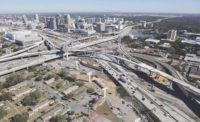Dubbed the “I-4 Ultimate,” the $2.3-billion, 21-mile-long reconstruction of Orlando’s only interstate highway is pushing the limits of public procurement while pressing contractors to deliver a massive, urban-intensive transformation. The design-build public-private partnership (P3) project stands as the Florida Dept. of Transportation’s largest-ever procurement, as well as one of the nation’s largest infrastructure contracts.
FDOT’s P3 agreement, signed in May 2014, charges concessionaire I-4 Mobility Partners with designing, constructing, financing, maintaining and operating the project for 40 years. The P3 team’s financial proposal included $105 million in equity provided by Skanska Infrastructure Development and John Laing Investments Ltd., along with a $950-million TIFIA loan and $487 million in bank debt, according to the state.
Construction scope is similarly ambitious. SGL Constructors—a joint venture of Skanska USA Civil Southeast, Granite Construction and Lane Construction—is rebuilding I-4’s existing general-use travel lanes and adding four tolled “managed” lanes for the full 21-mile length, while also reconstructing 15 major interchanges and constructing 140 bridges, 75 of which are located in the 4.2-mile-long Downtown bridge district portion of the project. That last section includes reconstruction of the I-4/S.R. 408 interchange, the project’s critical path.
Working simultaneously at multiple locations along the project’s full 21-mile length, the contractor is implementing roughly $1 million worth of work per day, says Jon Walker, SGL’s program project manager.
“With this big of a project to accomplish in six and a half years, you have to get spread out,” he says. Not quite two years in, and nearly four years from final completion in 2021, Walker says the contractor is roughly 38% percent complete for both time and revenue. “We’re very close to schedule on both aspects.”
SGL’s original plan divided the project into four areas. Starting from the project’s western end, these included the 5.7-mile “attractions” section; the 4.2-mile Downtown stretch; the 4.9-mile “Ivanhoe” section that runs from Ivanhoe Road to Kennedy Boulevard; and the 6.2-mile-long Altamonte section at the project’s eastern boundary. But plans have changed.
That’s because of the impending reconstruction of the project’s biggest engineering and construction challenge—the interchange with S.R. 408, a tolled highway owned by the Central Florida Expressway Authority (CFX). It was estimated to be a roughly $700-million endeavor if it were a stand-alone project, according to FDOT. The contractor quickly realized that this construction centerpiece required its own separate project manager, Walker says.
“We’ve reacted to the complexities and made some course corrections,” he says.
Considered the most complex interchange to design, according to the design team of HDR and Jacobs Engineering Group, the new interchange will be four levels, with the 408 mainline below and three flyover structures above.
The three flyover structures, all steel-box girder bridges, will vary from just over 1,710 ft long to more than 3,150 ft. The bridge linking westbound I-4 to westbound 408 measures 2,586 ft in length via 14 spans. The structure linking the westbound 408 to westbound I-4 will be the longest, at 3,154 ft. Lastly, a bridge connecting I-4 eastbound to westbound 408 will come in at 1,710 ft, with eight spans.
Constructibility proved an early head-scratcher for the project team, due in large measure to the interchange’s tight confines. Contractors had to figure out how to erect the three flyovers from atop the 408 mainline near Division Avenue, which was originally planned as an elevated structure.
As a solution, SGL proposed creating a 200-ft-long earthen plug in this section of the 408, to be constructed with fill on top of existing ground. The earthen plug will be contained by 26-ft-tall mechanically stabilized earth (MSE) walls, thereby enabling it to serve as a platform for erecting the I-4/SR 408 flyover bridges, says Alvaro Alonso, design-build manager with SGL.
SGL is currently working on the deep foundations for these elevated structures and will begin structural steel erection in the fourth quarter of 2018, Walker says.
The contractor expects to complete the I-4/408 interchange by late 2019, or more than one year ahead of overall completion, expected in early 2021.
Another engineering challenge awaits with the pedestrian bridge at Maitland Boulevard, which will be the longest cable-supported pedestrian bridge in the state, say designers. There, a 700-ft-long bridge comprised of a single steel arch rib will support a 600-ft-long, 12-ft-wide walkway that will curve horizontally as it crosses I-4. That structure is currently in the process of going out to bid.
Procuring Change
During the procurement process, most teams proposed building direct connections from I-4’s managed lanes to the S.R. 408 tollway. Without these direct connections, toll-paying drivers on I-4 would likely have to exit the managed lanes well in advance of the 408. This would not only impact tolls, but likely disrupt area traffic flows. The state hadn’t planned for that issue.
After a quick analysis, FDOT determined it had the right-of-way to accommodate the bigger bridges that constructing direct connections would require. Without increasing the project’s budget, the agency approved each bidder’s request to incorporate these connections via its Alternative Technical Concept (ATC) process. Used for all FDOT design-build procurements, the process enables bidders to propose alternative ideas that are deemed equal to or better than approaches initially prescribed by the state.
After granting each contractor’s request to increase the project scope without boosting the budget, “We didn’t know how this was going to play out,” says Loreen Bobo, FDOT’s I-4 Ultimate construction program manager. She adds that FDOT also had to secure approval from the Federal Highway Administration for this change. At bid day, all four teams incorporated direct connects into their proposals.
That wasn’t the only unexpected procurement-produced add-in. For Ultimate, FDOT took its ATC process to another level, Bobo says. Typically, the state incorporates approved ATCs into the final requests for proposals. This time, though, the state conducted its ATC process via confidential meetings with each bidder.
“We were the first project that went through a confidential ATC process, where we didn’t rewrite the RFP to accommodate the ATC,” Bobo says, adding that the approach appeared to boost innovation.
“Because we made it a confidential process, it wasn’t as clear to everybody what type of innovative ideas the department was interested in,” she says, a dynamic that appeared to motivate teams to be more forthcoming. “Making it confidential made it more innovative.”
In all, FDOT reviewed and approved 187 ATCs submitted from bidders, Bobo says.
The confidential process, however, produced an unexpected curiosity from bidders about the state’s true preferences, Bobo added. For instance, FDOT early stated a definitive safety-influenced preference to utilize concrete barrier walls to separate the tolled managed lanes from general-use lanes—instead of delineators, which are less costly to install. Still, numerous bidders queried FDOT during their ATC presentations about the possible use of delineators. In each case, the state emphatically rejected the option.
Later, Bobo said, bidders admitted they had little intention of proposing the use of delineators; they were probing whether the agency was secretly open to this lower-cost option to discern if it was allowing other teams to propose them.
Keeping costs down during the bidding stage definitely proved a challenge, as two of the short-listed teams submitted bids in excess of FDOT’s “upset limit,” or the maximum amount it could pay over the life of the contract.
In all, the state has roughly $1.723 billion to pay out over periodic payments and final acceptance payments, says Bobo. FDOT didn’t make its first periodic payment until day 630 of the contract, May 25, 2016. Those payments—numbering 17 in all—start at about $45 million and recur roughly every three months, eventually increasing to about $63 million.
At substantial completion—currently estimated at early 2021—the state will begin making quarterly availability payments to the concessionaire, I-4 Mobility Partners.
Annually, those availability payments—based on the facility remaining open and available to traffic—will max out at around $75 million, subject to inflation based on the consumer price index (CPI) and minus any assessments for not meeting performance measures. Those payments will continue until the end of the contract, in September 2054, and will cover “any and all maintenance,” says Bobo.
Also, an estimated 90 days after substantial completion, when FDOT estimates it will grant final acceptance, the state will make two other payments, of $300 million and $388 million, respectively, in subsequent years immediately following the project’s completion.
Prior to bidding, SGL gave I-4 Mobility Partners its CPM schedule—presently numbering 37,000 construction activities—to develop a “cash curve” to guide construction.
So far, Walker says, “We’ve been staying under that number.” However, he adds, “In a year and a half or two years, we think we’re going to be up to that number. But we’ll never want to slow down.”
He adds: “There’s just no way you cannot finish on time. Liquidated damages are well over $200,000 a day. Our overhead is well over $200,000 a day. You just have to finish on time. You’d rather have 20 more people (on staff) today than face the consequences of $400,000 a day” due to not finishing on schedule.
Currently, according to Walker, the project numbers 320 salaried SGL staff and 850 hourly craft employees. Subcontractor employees come in at around 350.
Design is roughly 99.8% complete, say engineers, with plan sheets topping 54,000 in all. At peak of engineering work, the project employed an estimated 480 full-time designers. That number is down to about 70 design professionals working on the job now.
Wins, Losses
While notable construction milestones still await, the project has already experienced other notable developments, both positive and negative.
On the positive side, the Institute for Sustainable Infrastructure recognized I-4 Ultimate with its Envision Platinum award. The honor recognizes the project team’s efforts to minimize environmental impacts, such as recycling 99% of the concrete and steel removed from roads and bridges, and for facilitating the use of alternative transportation modes through the integration of rail projects, improved pedestrian crossings and connections with bike trails.
Tragically, however, the project has suffered two fatalities to date. The first occurred in early 2016 when an employee, wearing earbuds, exited a portable restroom and walked onto a haul route directly in front of a subcontractor truck that was backing up, the contractor says. Evidence suggested the SGL worker, 34-year-old Marvin Franklin, never heard the truck’s back-up signal, says the contractor.
In response, SGL shut down construction for three days while project crews reviewed safety practices and procedures. Soon thereafter, the contractor added another item to its safety practices: lining all jobsite transportation and haul routes with green cones, along with the requirement for all workers to stop and look both ways before crossing.
A second fatality occurred when 59-year-old Curtis Popkey, with subcontractor Central Florida Underground, ventured too close to a load being offloaded from a truck. The Occupational Safety and Health Administration is currently investigating.
After this second loss of life, SGL implemented its controlled work zone practice, which requires that all workers entering a site first check in with the supervisor.
The contractor is attempting to ratchet up its emphasis on safety, which Walker feels was already a significant focus. “We’re trying to be on the cutting edge of safety,” he says.
In that regard, SGL is promoting other safety measures, such as mandating halo lights atop the hardhats of anyone working at night. Additionally, Walker says, the contractor has started experimenting with placing RFID tags within workers’ hardhats, so that equipment operators can be alerted to anyone coming into close proximity of a piece of equipment.
Says Walker, “We have decided that we needed to do something more than we’ve done in the past.”










